The Madness has returned.
While millions of basketball fans skip work, bet money, and otherwise plan their lives around the NCAA basketball, you’ve been infected with a sickness of a different kind. It’s less of a Madness and more of an addiction to hot rods and muscle cars.
That’s why we created Muscle Car Match-Ups.
Back by popular demand, this hot-rodded version of the NCAA basketball tournament places 16 muscle cars in a NCAA-style bracket to determine the top muscle car. And YOU determine the winner!
How it Works
Read up on our field of 16 muscle cars below and then vote. It’s that simple! There are even three—count ’em, three—easy ways to vote:
- Write all your first round picks in the comments section below.
- Follow OnAllCylinders on Facebook and vote on each individual match-up when we post it. You make your pick by commenting on your favorite.
- Follow Summit Racing Equipment’s Facebook page. Our friends at Summit Racing will post individual, head-to-head match-ups from the tournament, and you can comment on your favorite to vote.
The Bracket (Round 1)
Madness, sickness, addiction—whatever you call it, it has spread this year. In fact, our friends at BangShift and Power AutoMedia have gotten in on the fun by submitting four picks each for the initial field of 16. For this year, the tournament is divided into four regions: BangShift, Power AutoMedia, OnAllCylinders, and Summit Racing fan picks. Here’s how they stack up:
BangShift Region
1967 KR8 Tasca Mustang vs. 1963 Studebaker Lark R2
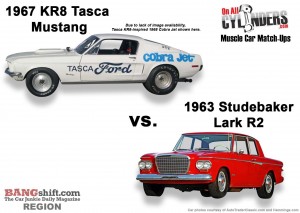 The 1967 KR8 Tasca Mustang is the car responsible for the entire Ford Cobra Jet movement. Dissatisfied with the car’s original 390 engine, Rhode Island car dealer Bob Tasca swapped out the motor for a 428 Police Interceptor engine built with his own combination of off-the-shelf parts. Ford used this engine package to create its now-famous Cobra Jet engine—and saved its reputation as the Total Performance company in the process! Note: Due to lack of quality images available for the ’67 Tasca KR8 Mustang, the image at left shows the Tasca-inspired 1968 Cobra Jet.
The 1967 KR8 Tasca Mustang is the car responsible for the entire Ford Cobra Jet movement. Dissatisfied with the car’s original 390 engine, Rhode Island car dealer Bob Tasca swapped out the motor for a 428 Police Interceptor engine built with his own combination of off-the-shelf parts. Ford used this engine package to create its now-famous Cobra Jet engine—and saved its reputation as the Total Performance company in the process! Note: Due to lack of quality images available for the ’67 Tasca KR8 Mustang, the image at left shows the Tasca-inspired 1968 Cobra Jet.
The guys at BangShift went outside the box here by including (ironically) the boxy Studebaker Lark R2. The Lark R2 came with a Paxton SN60-huffed 289 Jet-Thrust V8 which could propel the Lark to 60 miles-per-hour in roughly 6.3 seconds when used with the special High Performance Package. In short, the Lark R2 was sort of a muscle car before the term muscle car was popularized.
1971 AMC Hornet SC360 vs. 1966 427 Chevrolet Biscayne
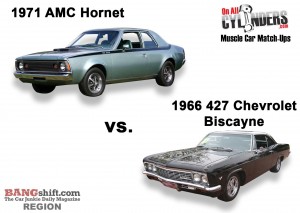 Featuring a 360-cubic-inch engine the 1971 AMC Hornet SC360 was American Motors’ follow-up to its 1969 SC Rambler. Motor Trend magazine described the sporty SC360 as “a gas to drive…it handles like a dream.”
Featuring a 360-cubic-inch engine the 1971 AMC Hornet SC360 was American Motors’ follow-up to its 1969 SC Rambler. Motor Trend magazine described the sporty SC360 as “a gas to drive…it handles like a dream.”
On the other end of the spectrum from the smaller AMC Hornet, the 1966 427 Chevrolet Biscayne was a full-size car that packed big block power in the form of a 425-horsepower 427 cubic-inch engine. More importantly, the base model Biscayne was lighter, more rigid, and less expensive than other full size Chevrolet models, making it a weapon of choice for mid-1960s drag racers.
Because of its entry-level appearance, the 427 Biscayne was the one of the ultimate sleeper cars of its day.
OnAllCylinders Region
1968 Dodge HEMI Dart vs. 1969 Pontiac GTO (the Judge)
If you’re all about performance muscle and nothing else, then the 1968 HEMI Dart is your choice. Only about 80 of the limited-production models were made, and they came about as bare bones as possible. No rear seats. No radio. No luxuries of any kind. Unless you consider a fire-breathing 426-cubic-inch elephant a luxury. With minimal modifications, the HEMI Dart was easily in the 10s in the quarter-mile.
Perhaps no muscle car better reflected American culture than the 1969 Pontiac GTO ‘the Judge” model, which was named after a popular comedy routine on Rowan & Martin’s Laugh-In. The Judge had a serious vibe, though, thanks to its standard 400 H.O. Ram Air III engine, Rally II wheels, spoiler, and wide tires.
1969 Mercury Cyclone 428CJ vs. 1970 Plymouth HEMI ‘Cuda
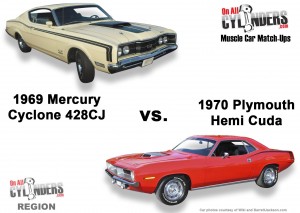 Available for one year only, the Mercury Cyclone 428CJ was a viable and desirable alternative to Ford’s popular muscle car lineup. The Cyclone followed the quintessential muscle car blueprint: big engine, midsize car, and stripped-down amenities. As the name suggests, you got 428 Cobra Jet potency in a rarer package than a more mainstream Ford product.
Available for one year only, the Mercury Cyclone 428CJ was a viable and desirable alternative to Ford’s popular muscle car lineup. The Cyclone followed the quintessential muscle car blueprint: big engine, midsize car, and stripped-down amenities. As the name suggests, you got 428 Cobra Jet potency in a rarer package than a more mainstream Ford product.
We’ve brought the 1970 Plymouth HEMI ‘Cuda back for another run at the title. In our opinion, it’s hard to think of another car more killer than the venerable HEMI ‘Cuda. Even if you don’t put it past the second round, you won’t convince us otherwise. It featured Mopar’s brand new E-body, incorporated the almighty HEMI engine, and came standard with a distinctive shaker.
Power AutoMedia Region
1969 Ford Mustang Boss 429 vs. 1965 Pontiac GTO
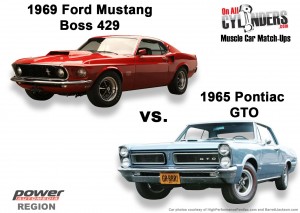 Rare, but undeniably awesome, the 1969 Ford Boss 429 featured Ford’s 429 cubic-inch engine (go figure). The engine was developed for NASCAR use and built to compete with Mopar’s popular HEMI engine. In the end, only 859 Boss 429s were made, and the car remains highly collectible.
Rare, but undeniably awesome, the 1969 Ford Boss 429 featured Ford’s 429 cubic-inch engine (go figure). The engine was developed for NASCAR use and built to compete with Mopar’s popular HEMI engine. In the end, only 859 Boss 429s were made, and the car remains highly collectible.
Pontiac took the car that arguably launched the whole muscle car genre in 1964 and made it even better for 1965. The 1965 GTO featured revised cylinder heads and a high-rise intake that bumped its 389 Tri-Power engine package to 360 horsepower.
1969 Chevrolet Camaro Z/28 vs. 1970 Buick GSX
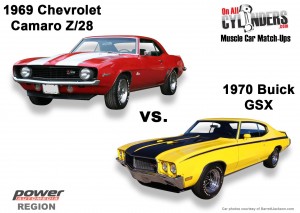 Just like last year’s competition, our field includes select pony cars. However, only cream-of-the-crop pony cars like the 1969 Camaro Z/28 have earned honorary muscle car status for this year. The first-generation Camaro is the most sought-after, and its 302-powered Z/28 version was developed for Trans-Am racing.
Just like last year’s competition, our field includes select pony cars. However, only cream-of-the-crop pony cars like the 1969 Camaro Z/28 have earned honorary muscle car status for this year. The first-generation Camaro is the most sought-after, and its 302-powered Z/28 version was developed for Trans-Am racing.
In a rematch from last year, the Z/28 takes on the Buick GSX. The 1970 Buick GSX was the high performance package for the Gran Sport and featured a stout 455 cubic-inch engine. The Stage 1 version used a more aggressive cam and higher compression for even greater output.
Summit Racing Fans
1969 Chevrolet Yenko Nova vs. 1965 Shelby Cobra 427
Clearly, Summit Racing fans brought their A-game this year. The ’69 Yenko Nova was the lightest in the famed Yenko 427 lineup and could go zero to 60 miles-per-hour in an astonishing four seconds! Only 37 of these 425-horsepower beasts were built. That’s bad news for performance junkies—and probably good news for society at large!
We already know what some of you are thinking: “The 1965 Shelby Cobra isn’t a muscle car.” To you, we say: “Scoreboard”—as in check last year’s scoreboard because your peers voted this as the 2013 champion. The 1965 Shelby Cobra 427 has earned the right to defend its title. And oh yeah…the 510-horse, 427-powered Cobra remains one of the quickest cars of all time. So there’s that, too.
1969 Dodge Charger R/T vs. 1970 Chevrolet 454 Chevelle SS
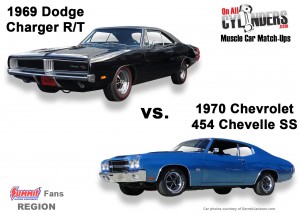 With 440 cubic inches of Mopar power and a heavy-duty suspension package, the 1969 Dodge Charger R/T oozed muscle. And that was long before them Duke boys took the popularity of the ’69 Charger to new heights in the Dukes of Hazzard.
With 440 cubic inches of Mopar power and a heavy-duty suspension package, the 1969 Dodge Charger R/T oozed muscle. And that was long before them Duke boys took the popularity of the ’69 Charger to new heights in the Dukes of Hazzard.
When GM lifted its ban on 400-plus cubic-inch motors in mid-sized cars, Chevrolet responded in a big way. Its popular Chevelle SS model was now available with a 454-cubic-inch engine, and an LS6 option gave the Chevelle 454 SS 450 horsepower. It was one of the most powerful vehicles that anyone could purchase.
Vote now in the comments section to ensure your favorites move on to the second round!

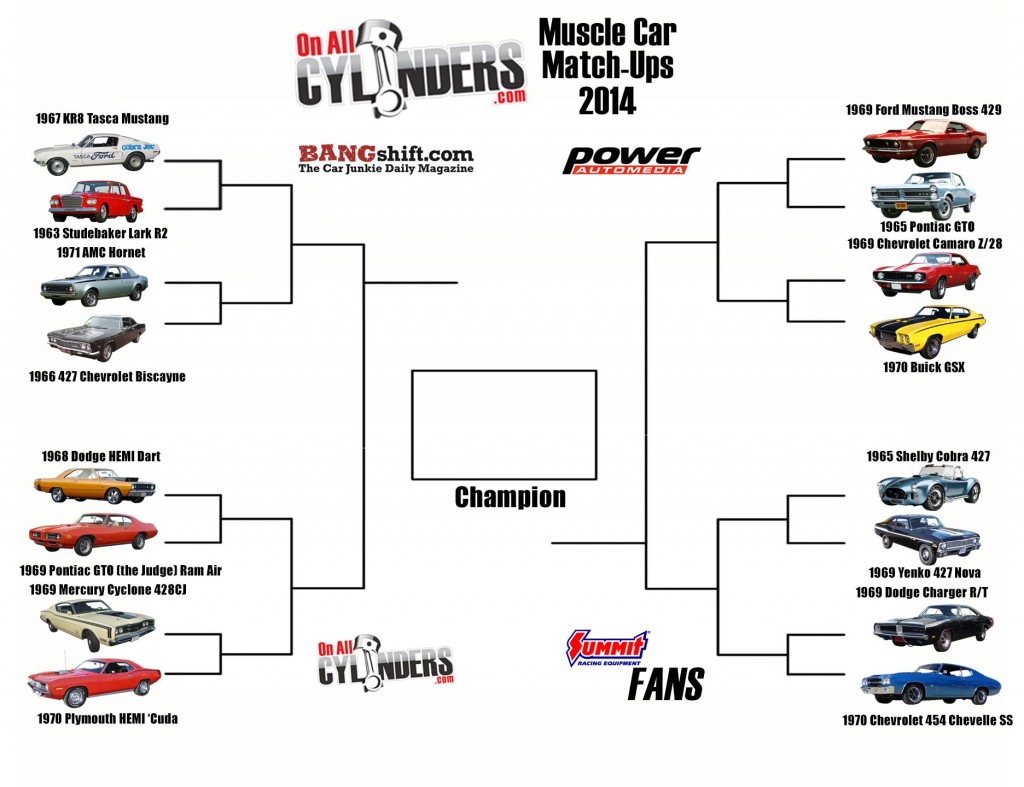
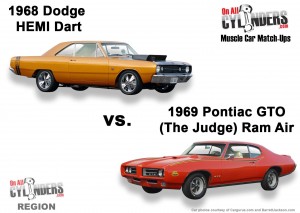
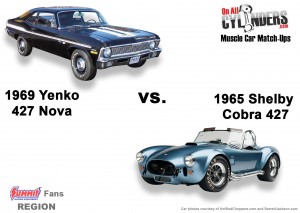
– 63 Studebaker
– 71 Hornet
– 68 Dart
– 69 Cyclone
– 69 Boss
– 69 Camaro
– 69 Yenko Nova
– 70 Chevelle
– 63 Studebaker
– 71 Hornet
– 69 GTO
– 70 Cuda
– 69 Boss
– 69 Camaro
– 65 Cobra 427
– 69 Charger
Tasca Mustang
66 Biscayne
Hemi Dart
Cyclone
Boss 429
Z28
Cobra
Charger
67 tasca Mustang
66 chevy Biscayne
69 GTO Judge
70 hemi cuda
69 Boss 429
69 Camaro z/28
65 Shelby Cobra 427
70 Chevelle 454 SS
Mustang
Hornet
Dart
Cuda
Mustang
GSX
Shelby
Chevelle
1967 KR8 Tasca Mustang
1966 427 Chevrolet Biscayne
1968 Dodge HEMI Dart
1970 Plymouth HEMI ‘Cuda
1969 Ford Mustang Boss 429
1969 Chevrolet Camaro Z/28
1965 Shelby Cobra 427
1969 Dodge Charger R/T
67 Tasca KR8
71 Hornet
68 Hemi Dart
70 Hemi Cuda
69 Boss 429
70 Buick GSX
65 Shelby Cobra 428
69 CHARGER R/T
Mustang, hornet, GTO, Boss 429, camaro, Cobra, Chevelle
Mustang, hornet, GTO, Cuda Boss 429, camaro, Cobra, Chevelle
Mustang
Mustang
Hornet
Dart
Cuda
GTO
Buick
Cobra
Charger
How about a 1970 Olds 442 W-30.
67 Tasca mustang
66 427 Biscayne
68 Hemi Dart
70 Hemi Cuda
65 GTO
69 Camaro
69 Yenko Nova
70 Chevelle
1967 KR8 Tasca Mustang, 1966 427 Chevrolet Biscayne, 1968 Dodge Hemi Dart, 1970 Plymouth Hemi Cuda, 1969 Ford Mustang Boss 429, 1970 Buick GSX, 1965 Shelby Cobra 427, 1970 Chevrolet Chevelle SS
Mustang
Biscayne
Dart
Cuda
Boss 429
GSX
Cobra
Charger
67 Tasca Mustang
1966 427 Chevrolet Biscayne
Hemi Dart
Hemi Cuda
Boss 429
69 Z28
Cobra
Charger R/t
1969 Camaro Z/28
1970 Chevelle SS 454
1970 Plymouth HEMI Cuda
1969 Nova Yenko 427
1969 GTO (The Judge)
1966 Biscayne
1965 GTO
1967 Mustang
Mustang
Hornet
Dart
Cyclone
Boss
GSX
Shelby
Charger
1967 KR8 Tasca Mustang
1971 AMC Hornet SC360
1969 Pontiac GTO (The Judge)
1970 Plymouth Hemi Cuda
1965 Pontiac GTO
1970 Buick GSX
1965 Shelby Cobra 427
1969 Dodge Charger R/T
BOOGITY BOOGITY BOOGITY! LET’S GO RACING BOYS!
Tasca Mustang,
Chevy Biscayne
Hemi Dart
Hemi Cuda
Boss 429
Z28 Camaro
Yenko Nova
Chevelle
Tasca Mustang
66 Biscayne
Hemi Dart
Hemi Cuda
Boss 429
Buick GSX
Shelby 427 Cobra
69 Charger
67 mustang,66 chevy,68 dart,69 mustang,70 buick,65 cobra,69dodge
1963 Studabaker Lark R2
1966 427 Chevrolet Biscayne
1969 Pontiac GTO (The Judge) Ram Air
1970 Plymouth Hemi Cuda
1965 Pontiac GTO
1969 Chevrolet Camaro Z/28
1969 Yenko 427 Nova
1970 Chevrolet 454 Chevelle SS (Last one was probably the hardest choice out of all of them)
1967 KR8 Tasca Mustang
1966 427 Chevrolet Biscayne
1969 Pontiac GTO (the Judge)
1970 Plymouth HEMI ‘Cuda
1969 Ford Mustang Boss 429
1969 Chevrolet Camaro Z/28
1969 Chevrolet Yenko Nova
1970 Chevrolet 454 Chevelle SS
1967 KR8 Tasca Mustang
1971 AMC Hornet SC360
1969 Pontiac GTO (The Judge)
1970 Plymouth Hemi Cuda
1969 Ford Mustang Boss 429
1970 Buick GSX
1965 Shelby Cobra 427
1969 Dodge Charger R/T
63 Studebaker Lark
66 427 Biscayne
68 Hemi Dart
70 Hemi Cuda
65 GTO
69 Z 28
69 427 Yenko Nova
70 SS 454 Chevelle
63 Studebaker
71 AMC Hornet
68 Hemi Dart
70 Hemi Cuda
69 Mustang Boss
70 Buick GSX
69 Yenko Nova
69 Charger
Tasca Mustang
Chevy Biscayne
Pontiac GTO
Plymouth Hemi Cuda
Mustang Boss
Camaro Z28
Cobra 427
Dodge Charger
Mustang
Biscayne
Hemi Dart
Hemi Cuda
GTO
Camaro
Nova
Chevelle
67 tasca mustang,66 biscayne, gto,70 hemi cuda,69 mustang,69 camaro,65 shelby,69 charger
67 Tasca Mustang
66 Chevy Biscayne
69 Pontiac GTO
70 Hemi Cuda
65 Pontiac GTO
69 Camaro X28
69 Yenko Nova
70 Chevelle SS
Mustang
Biscayne
GTO
Cuda
Mustang
Camaro
Cobra
Chevelle
67 Tasca Mustang
1963 Studebaker Lark R2
1971 AMC Hornet
1968 Dodge Hemi Dart
1970 Plymouth Hemi Cuda’
1969 Ford Mustang Boss 429
1969 Chevrolet Camaro Z28
1965 Shelby Cobra 429
1969 Dodge Charger R/T
1967 KR8 Tasca Mustang
1966 427 Chevrolet Biscayne
1969 Pontiac GTO ‘the Judge”
1969 Mercury Cyclone 428CJ
1969 Ford Boss 429
1969 Camaro Z/28
1965 Shelby Cobra
1969 Dodge Charger R/T
63 Lark R3
71 Hornet
68 Hemi Dart
70 Hemi Cuda
69 Boss 429 Mustang
70 Buick GSX
65 427 Cobra
69 Charger RT
Tasca Mustang
Biscayne
GTO
Cyclone
Boss 429
Z/28
Cobra
Charger R/T
1967 KR8 Tasca Mustang
1966 427 Chevrolet Biscayne
1969 Pontiac GTO ‘the Judge”
1969 Mercury Cyclone 428CJ
1969 Ford Boss 429
1970 Buick GSX
1965 Yenko Nova
1969 Dodge Charger R/T
Mustang
Hornet
Dart
Cuda
Boss Mustang
GSX
Shelby Cobra
Charger
67 Tasca Mustang
66 427 Biscayne
69 Pontiac GTO “The Judge”
69 Mercury Cyclone 428CJ
69 Ford Boss 429
69 Yenko Nova
70 Chevelle SS 454
67 kr8 tasca.
66 427 Biscayne.
68 hemi dart
69 cyclone 428 cj
boss 429
buick GSX
yenko 427 nova
charger R/T
67 Mustang
Chev Biscayne
Hemi Dart
Hemi Cuda
429 Mustang
Buick GSX
427 Cobra
69 Charger
Round 1:
67 tasca mustang
66 Biscayne
68 hemi dart
70 hemi cuda
65 GTO
70 GSX
69 Yenko Nova
70 Chevelle
67 Tasca Mustang, 66 427 Biscayne, 68 Hemi Dart, 70 Hemi cuda, 69 Boss 429, 70 GSX, 65 Shelby cobra 427, 69 Charger R/T 440!
1967 KR8 Tasca Mustang
1966 427 Chevrolet Biscayne
68 Hemi Dart
70 Hemi Cuda
1969 Ford Boss 429
1969 Camaro Z/28
’69 Yenko Nova
1969 Dodge Charger R/T
1969 Charger,68 Hemi Dart,70Hemi Cuda,69Yenko Nova,66 Chevy 427 Biscayne, 70 Buick GSX,69 Boss 429 Mustang,67Tasta Mustang
Studebaker
Biscayne
Dart
Cuda
mustang
GSX
Cobra
Chevelle
Mustang
Hornet (most people don’t know what an SC/360 Hornet is!)
Dart
Mercury
Mustang
GSX
Cobra
Charger
67 Tasca mustang
66 427 Biscayne
68 Hemi Dart
70 Hemi Cuda
65 GTO
69 Camaro
69 Yenko Nova
70 Chevelle
Nr 1: 1970 Buick GSX
62 Studebaker Lark
71 AMC Hornet
68 HEMI Dart
70 Plymouth HEMI Cuda
69 Boss 429
70 Buick GSX
69 Yenko Nova
68 Dodge Charger
1967 KR8 Tasca Mustang
1966 427 Chevrolet Biscayne
1968 Hemi Dodge Dart
1970 Plymouth Hemi Cuda
1969 Ford Boss 429
1970 Buick GSX
1965 Shelby Cobra 427
1969 Dodge Charger R/T
The 1968 Hemi Dart should be the Champion. It was designed to race. 🙂
67 stang, 66 Biscayne, Hemi dart, Hemi cuda, Boss 429, Gsx, Yenko Nova, 69 Charger
1967 Tasca Mustang
1966 Chevrolet Biscayne
1965 Pontiac GTO
1969 Camaro z28
1965 Shelby Cobrfa 427
1969 Dodge Charger R/T
1968 Dodge Hemi Dart
1970 Plymouth Hemi Cuda
1970 SS Chevelle 454 LS6
1968 Yenko 427 Nova
1969 Z/28 Camaro
1965 pontiac gto
1970 Hemi ‘Cuda
1969 gto “Judge”
1966 427 Chevrlet Biscayne
1968 Tasca Mustang
67 tasca mustang
66 chevrolet biscayne
69 pontiac gto
70 plymouth cuda
69 mustang boss
69 chevrolet camaro
65 shelby cobra
70 chevrolet 454 chevelle ss
1967 KR8 Tasca Mustang
1966 427 Chevrolet Biscayne
1969 Pontiac GTO ‘the Judge”
1970 Plymouth HEMI ‘Cuda
1969 Ford Boss 429
1969 Camaro Z/28
1969 Chevrolet Yenko Nova
1969 Dodge Charger R/T
67 Tasca Mustang, 66 427 Biscayne, 68 Hemi Dart, 69 Mercury Cyclone 428CJ, 69 Boss 429, 70 Buick GSX, 65 Shelby Cobra, 70 Chevelle 454SS
67 Tasca Mustang
66 427 Biscayne
68 Hemi Dart
69 Cyclone 428CJ
69 Mustang Boss 429
69 Camaro Z/28
65 Shelby Cobra
69 Charger R/T
Chevelle 454 SS ’69 Yenko Nova1970 Buick GSX1965 GTO 1970 Plymouth HEMI ‘Cuda 1969 Pontiac GTO 1966 427 Chevrolet Biscayne 1967 KR8 Tasca Mustang
67 mustang
66 Biscayne
68 dodge dart
70 hemi cuda
69 429 mustang
69 Camaro
65 cobra 427
69 dodge charger r/t
Mustang
66 427 Biscayne
69 judge
70 cuda
65 gto
69 z28
69 yenko nova
70 chevelle SS
67 Tasca mustang
66 427 Biscayne
68 Hemi Dart
70 Hemi Cuda
65 GTO
70 Buick GSX
69 Yenko Nova
69 Charger
63 stude 71 hornet 68 dart 70 cuda 69mustang 70gsx 65shelby 69charger
Mustang
Hornet
Gto
Camaro
Nova
Charger
Chevelle ss
stang
Biscayne
dart
cuda
stang
gsx
nova
charger
67 KR8 Tasca Mustang
66 427 Chevrolet Biscayne
68 Dodge Hemi Dart
70 Plymouth Hemi Cuda
69 Ford Mustang Boss 429
69 Chevrolet Camaro Z/28
65 Shelby Cobra 427
70 Chevrolet 454 Chevelle
69 Yenko Nova
67 Tasca mustang
66 427 Biscayne
68 Hemi Dart
70 Hemi Cuda
65 GTO
70 Chevelle
69 Camaro
67 tasca mustang
66 427 biscayne
68 hemi dart
70 hemi cuda
69 mustang
buick gsx
yenco nova
70 chevy chevelle
1967 KR8 Tasca Mustang.
1971 AMC Hornet.
1968 Dodge Hemi Dart.
1970 Plymouth Hemi Cuda.
1969 Ford Mustang Boss 429.
1970 Buick GSX.
1965 Shelby Cobra.
1969 Dodge Charger R/T.
1967 Tasca mustang 1969 dodge charger r/t 1965 Pontiac GT 1970 Plymouth cuda 1965 Shelby 427 cobra 1969 Camaro Z/28 1968 dodge hemi dart 1971 AMC Hornet.
1969 dodge charger r/t,1967 tasca mustang,1965 Shelby cobra 427,1970 hemi cuda,1968 Plymouth hemi dart,1969 Camaro,1965 Pontiac GTO,1971 AMC hornet.
1967 KR8 Tasca Mustang
1966 427 Chevrolet Biscayne
1968 HEMI Dart
1970 Plymouth HEMI ‘Cuda
1969 Ford Boss 429
1970 Buick GSX
1969 Yenko Nova
1969 Dodge Charger R/T
67 Mustang, 71 AMC Hornet, 69 Pontiac GTO, 69 Mercury Cyclone, 69 Mustang Boss 429, 69 Buick GSX, 65 Shelby Cobra, 70 Chevelle 454
67 Tasca mustang
66 427 Biscayne
68 hemi dart
70 hemi cuda
69 boss 429
69 z/28 Camaro
cobra
charger
[…] Not caught up? Check out our post introducing the 2014 Muscle Car Match-Ups tournament. […]
Chevelle 454 SS
67 KR8 Tasca Mustang
66 Biscayne
69 GTO Judge
69 Hemi Cuda
69 Boss 429
69 Z/28
65 Shelby Cobra
70 Chevelle
Studebaker and Hornet for round 1.
Agreed: Lark and Hornet
1963 Studebaker